Dallas Police Chief David Brown is on the ropes. Thanks to an increase in violent crime over the first third of 2016, discontented police unions and a City Council that's seemingly grown weary of his days as chief seem numbered. The media, the Observer included, has been all over crime stats, reporting a 75 percent jump over the first quarter of 2015. The numbers are scary and it's easy to expect Brown to do something about them, but maybe he can't.
Brown, who, it should be noted, has always touted the stats when they've helped his case, happens to be running DPD at a time when the absolute number of murders is lower than it's been in a long time. The Brennan Center's recently released Crime in 2015 report puts it succinctly:
"The 2015 murder rate rose by 13.2 percent in the 30 largest cities, with 19 cities seeing increases and 6 decreases. However, in absolute terms, murder rates are so low that a small numerical increase can lead to a large percentage change," the report says.
Through the middle of March in 2015, Dallas had seen 24 murders. By the same point this year, 41 people in Dallas had been killed. Scott Henson, editor of the influential Grits for Breakfast criminal justice blog, says there is nothing you can take away from those numbers.
"Murder rates matter, they do, but they are subject to that small number problem. They can only be interpreted, really, over time," he says. "There's a reason that the smallest poll anybody does is 400. If you're doing a political poll, no one really does less than 400 people because that's like 5 percent margin of error. Murder rates are a lot lower than that. It's just a statistically widely varying data point."
The reasons people kill other people are often particular and not repetitive, Henson says. They aren't something on which the police chief can have much of a real effect. Things like burglaries and assaults, crimes Dallas has not seen a significant increase in, are more easily predictable, but it's hard to judge anything over a quarter of a year, Henson says.
"Here's the part that journalists are so terrible about promoting. These first three months of the year crime stats that everyone always comes out with and says 'oh crime did this,' those are worthless. That is such a small sample and anything from the weather to, you know, who won the Super Bowl, there are so many things that can effect those numbers. You always have to wait and see," Henson says.
Part of Brown's problem, as Eric Nicholson reported for the Observer at the end of March, is that he's made his name as a police chief by touting the very stats that now threaten to doom him.
"There's a extent to which this is, and Brown's not alone in this, but there's some chickens coming home to roost because, for years, when crime would go down, there was the claim that the police department was the cause," Henson says.
Over the last 30 years, murder rates have gone down drastically nationally while clearance rates have dipped from over 90 percent to in the 60 percent range Henson says. Thinking that police have caused a decline in the number of murders, or that they can do something that would make them go up drastically over a short time, is stupid, he says.
"Is [blaming Brown] fair? No.," Henson says. "Was it intellectually justifiable when you took credit for things going in the other direction? Also no. So, that's the position that Brown's put himself in."
[
{
"name": "Air - MediumRectangle - Inline Content - Mobile Display Size",
"component": "18855504",
"insertPoint": "2",
"requiredCountToDisplay": "2"
},{
"name": "Editor Picks",
"component": "17105533",
"insertPoint": "4",
"requiredCountToDisplay": "1"
},{
"name": "Inline Links",
"component": "18349797",
"insertPoint": "8th",
"startingPoint": 8,
"requiredCountToDisplay": "7",
"maxInsertions": 25
},{
"name": "Air - MediumRectangle - Combo - Inline Content",
"component": "17105532",
"insertPoint": "8th",
"startingPoint": 8,
"requiredCountToDisplay": "7",
"maxInsertions": 25
},{
"name": "Inline Links",
"component": "18349797",
"insertPoint": "8th",
"startingPoint": 12,
"requiredCountToDisplay": "11",
"maxInsertions": 25
},{
"name": "Air - Leaderboard Tower - Combo - Inline Content",
"component": "17105535",
"insertPoint": "8th",
"startingPoint": 12,
"requiredCountToDisplay": "11",
"maxInsertions": 25
}
]











